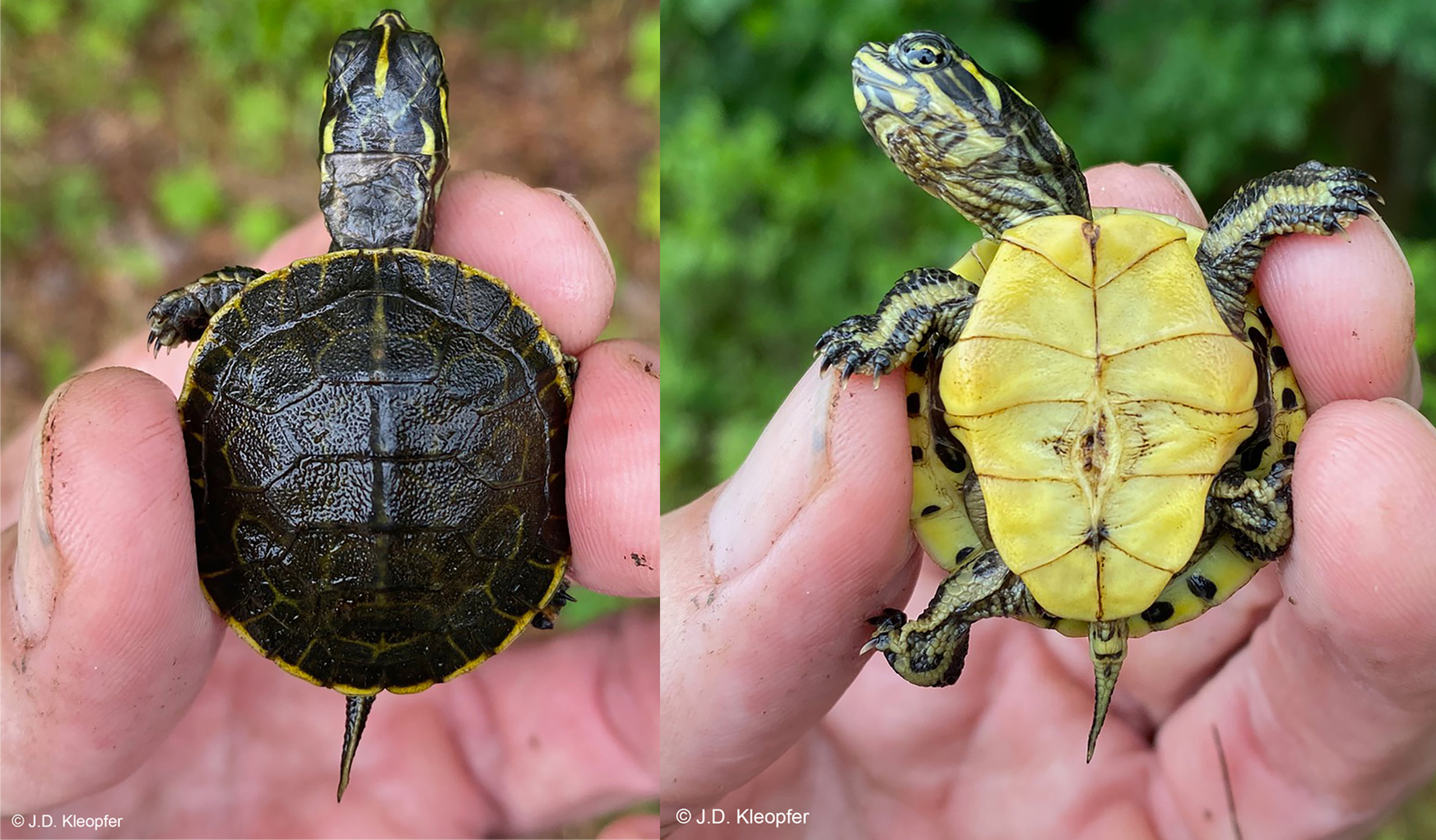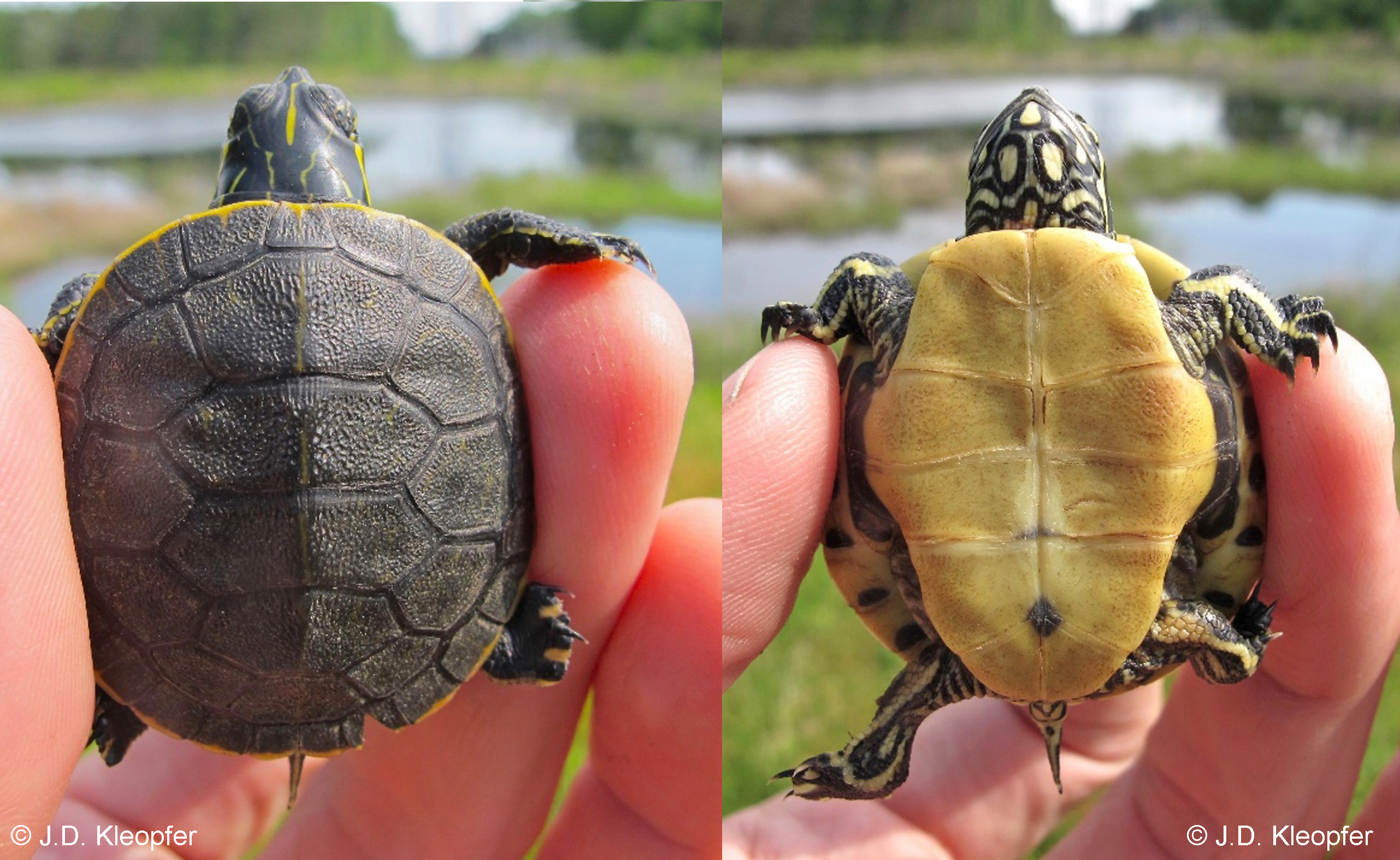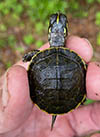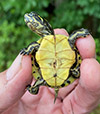Eastern Chicken Turtle
Deirochelys reticularia reticularia
Common Name: |
Chicken Turtle |
Scientific Name: |
Deirochelys reticularia reticularia |
Etymology: |
|
Genus: |
Deirochelys is derived from the Greek word deire which means "neck" and chelys which means "tortoise". |
Species: |
reticularia is from the Latin word reticulatus which means netlike referring to the pattern on the carapace. |
Subspecies: |
reticularia is from the Latin word reticulatus which means net like referring to thepattern on the carapace. |
Average Length: |
4 - 6 in. (10 - 15.2 cm) |
Virginia Record Length: |
8.8 in. (22.5 cm) |
Record length: |
10 in. (25.4 cm) |
Systematics: Originally described as Testudo reticularia by Pierre-Andre Latreille in 1801 from a specimen (now lost) collected between 1798 and 1800 in "Carolina." Harper (1940) restricted the type locality to Charleston, South Carolina. Louis Agassiz (1857) first used the genus Deirochelys for this species. All Virginia authors have used the current nomenclature. Three subspecies are recognized: D. reticularia chrysea Schwartz, D. reticularia miaria Schwartz, and D. reticularia reticularia (Latreille). The distributions of these races were illustrated in Zug and Schwartz (1971) and Conant and Collins (1991). Only the nominate subspecies is found in Virginia.
Description: A moderate-sized freshwater turtle reaching a maximum carapace length (CL) of 254 mm (10 inches) (Conant and Collins, 1991). In Virginia, known maximum CL is 225 mm, maximum plastron length (PL) is 240 mm, and maximum body mass is 1628 g.
Morphology: Carapace elongated and high-domed; carapacial surface rough with numerous longitudinal ridges (striations); marginals 12/12, pleurals 4/4, and vertebrals 5; cervical scute narrow; 1st vertebral scute contacts cervical and 4 marginal scutes; hingeless plastron 88-91% of CL; head and neck long, nearly length of carapace when fully extended.
Coloration and Pattern: Carapace brown to olive with a reticulate (netlike) pattern of yellow to light brown; black spots may be present on ventral side of the marginal scutes, especially posteriorly; hingeless plastron plain yellow with a poorly defined, faded blotch posteriorly on it in some individuals; an elongated black stripe occurs on bridge on some individuals but is absent in others; neck with thin yellow stripes on black skin; each foreleg with a broad yellow stripe anteriorly; vertical alternating yellow-and-black stripes on rear of thighs.
Sexual Dimorphism: Five adult females from the Virginia Beach population averaged 182.6 ± 17.7 mm CL (153.7-200.0) and 165.4 ± 16.1 mm PL (139.1- 180.0). Two females weighed 523 g and 974 g. Three adult males averaged 128.4 ± 14.3 mm CL (117.8-144.6), 112.9 ± 14.2 mm PL (103.4-129.2), and 281.7 ± 97.2 g body mass (205-391). Sexual dimorphism index based on CL was 0.42. Females have higher domed shells than males. The cloacal opening extends beyond the posterior edge of the carapace in males. Precloacal tail length in one female was 6.2 mm and was 15.2-22.2 mm (ave. = 19.0 ± 3.5) in three males. Based on 21 females captured at the Isle of Wight County site, the average size was 180.5 mm CL (107-224) with a maximum weighed 1,623 g. Males (N=32) averaged 137.6 mm CL (96-170) with a maximum weight of 627 g.
Juveniles: Juveniles are colored and patterned as adults but are brighter. Hatchlings from Florida were 28-32 mm PL (ave. = 30.1) and weighed 8.1-9.0 g (ave. = 8.5) (D. Jackson, 1988). Two hatchlings captured in May from Isle of Wight County both measured 32 mm CL. Two yearling turtles also captured in May measured 38 mm and 37 mm CL.
Confusing Species: No other Virginia turtle has such a long head and neck. Chrysemys picta has a flattened shell, brightly colored marginals, and usually 2 yellow spots behind each eye. Pseudemys rubriventris has reddish vertical streaks on the pleural scutes and Trachemys scripta has a yellow vertical bar or reddish stripe behind the eye. The 1st vertebral scute contacts the cervical and 2 marginals in these species.
Geographic Variation: None in Virginia. Schwartz (1956b) described the variation in color and pattern in each of the three subspecies.
Biology: In Virginia, the Chicken Turtle occupies freshwater, interdunal, cypress ponds, and sinkholes. Elsewhere in its range it inhabits ponds, lakes, ditches, and cypress swamps (Ernst and Barbour, 1989a). It is a basking turtle. J. W. Gibbons (pers. comm.) has captured these turtles in every month of the year in South Carolina, although they have been most abundant in March and April. Terrestrial movement occurs in both sexes in the Virginia localities, and some individuals spend considerable time on land just beneath the leaf litter (K. A. Buhlmann, pers. comm.; J.D. Kleopfer pers comm.) A radio-telemetry study conducted at the Isle of Wight County site showed brumation occurs terrestrially and that turtle may remain in the ponds as late as early December. Brumation occurred in forested areas under leaf litter (Kleopfer unpublished data).
Ernst and Barbour (1972) noted that Chicken Turtles are omnivorous and have been observed to eat crayfish, tadpoles, and aquatic plants, but D. Jackson (1988) stated that it is a "strict carnivore that feeds primarily on arthropods." A single road-killed specimen from the Virginia population had eaten a crayfish and a carabid beetle. While being temporarily held in preparation for a radio-telemetry study, Kleopfer observed that a chicken turtle had defecated the wings of an odonate, which appeared to be that of an unknown species of dragonfly.
Except for the observations that a road-killed female contained oviductal eggs on 20 May 1964 and one live female was gravid on 1 June 1991 (K. A. Buhlmann, pers. comm.), additional reproductive information is not available for Chicken Turtles in Virginia. No gravid females have been found at the Isle of Wight County site, but surveys primarily occurred in May (Kleopfer pers. comm.). The following information is derived from Gibbons (1969), Gibbons and Greene (1978), and Congdon et al. (1983). Clutch size was 5-11 eggs. Eggs averaged about 35 x 21 mm. Females laid up to two clutches per year, one in early spring and one in fall. The earliest egg-laying date in South Carolina was mid-February. Size at maturity was 141-154 mm PL for females and 75-80 mm PL for males. Nesting ecology is unknown. Hatchlings, especially those of fall eggs, overwintered in the nest and emerged in the spring. This scenario was confirmed in Virginia with the capture of two hatchings in the spring of 2024 (Kleopfer unpublished data). In Florida, clutch size was 2-19, number of clutches per season was two to four, the incubation period was 78-88 days, and nesting extended from late September to mid-March (D. Jackson, 1988).
| Hatchling Eastern Chicken Turtle Isle of Wight County (32 mm CL) Capture Date: May 24, 2024 |

|
| Yearling Eastern Chicken Turtle Isle of Wight County (37 mm CL) Capture Date: May 20, 2014 |

|
The biology of the Virginia populations is limited, and it has been little studied elsewhere compared with other turtle species. Gibbons (1987) determined that most adult Chicken Turtles in South Carolina lived to be greater than 10 years of age and some reached 20 years. Kleopfer (pers. comm.) believes the Isle of Wight County site may only have 20-30 adult turtles, while the Virginia Beach location is most likely biologically extinct as only 3 individual turtles have been captured there since 2005.
Remarks: The Chicken Turtle was first discovered in Virginia on 22 August 1958 by Roger H. de Rageot and W. Leslie Burger, who found a skeleton at Cape Henry (de Rageot, 1968). It was apparently common in the early 1970s (C. A. Pague, pers. comm.), but efforts during 1989-1992 failed to record more than nine live individuals. Surveys conducted by DWR and State Parks staff since 2005 have only produced 3 individuals, while surveys conducted at the Isle of Wight County location between 2012 and 2024 have produced 50 adults, 2 yearlings, and 2 hatchlings. There is an unconfirmed sighting in the City of Chesapeake (G. W. Williamson, pers. comm.).
Conservation and Management: The Chicken Turtle was officially listed as endangered under Virginia's endangered species law on 1 October 1987. Predation by raccoons (Procyon lotor) and Snapping Turtles (Chelydra serpentina), both abundant at First Landing State Park (formerly Seashore State Park), is probably the chief cause of mortality. Additional mortality is occasionally caused by vehicular traffic as one of the 3 turtles captured by State Parks staff had an old injury that was characteristic of a vehicular strike. Human activity in the park may disturb females laying eggs (Mitchell and Buhlmann, 1991). Active management (removal or translocation) of the two primary predators may enhance the survival of the Chicken Turtle population. This small population should be frequently monitored.
References for Life History
Photos:
*Click on a thumbnail for a larger version.
Verified County/City Occurrence
Isle of Wight CountyVirginia Beach CityIsle of Wight
CITIES
Virginia Beach
Verified in 1 county and 1 city.










